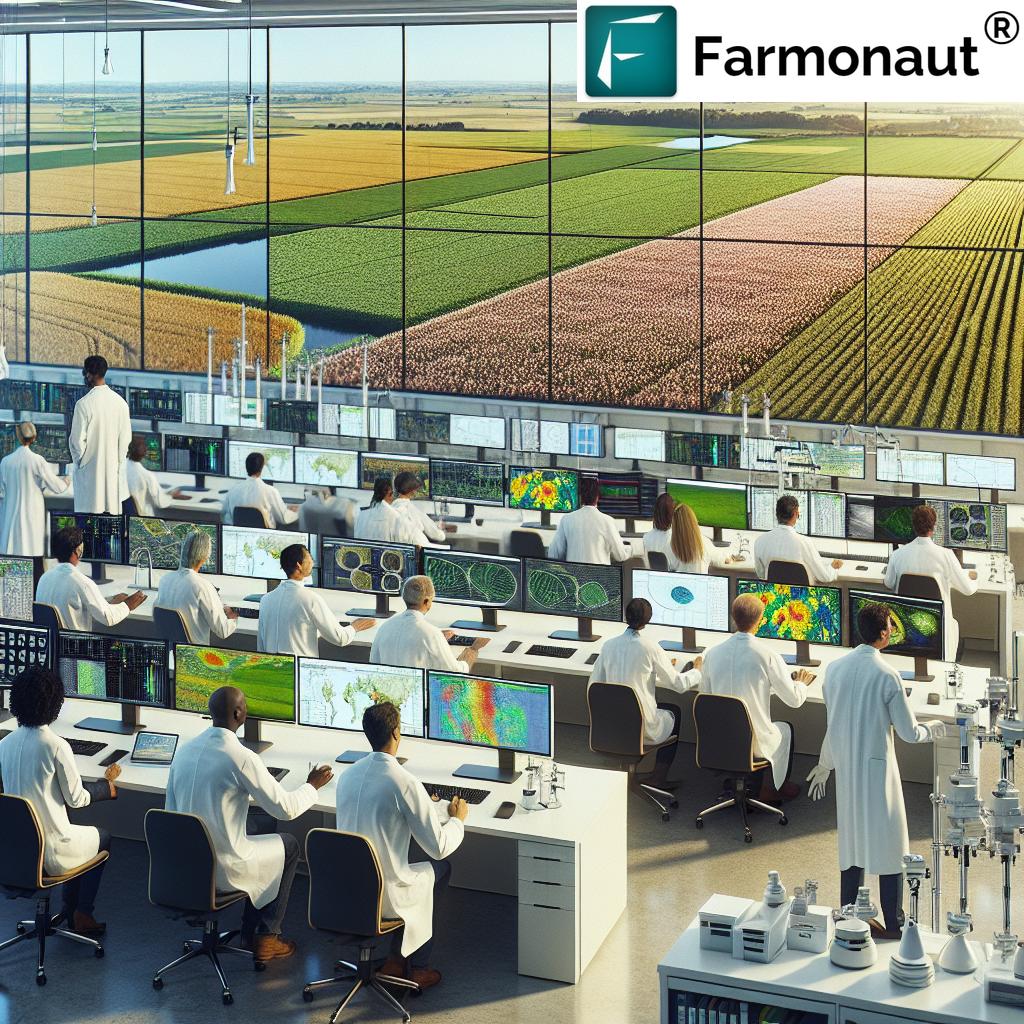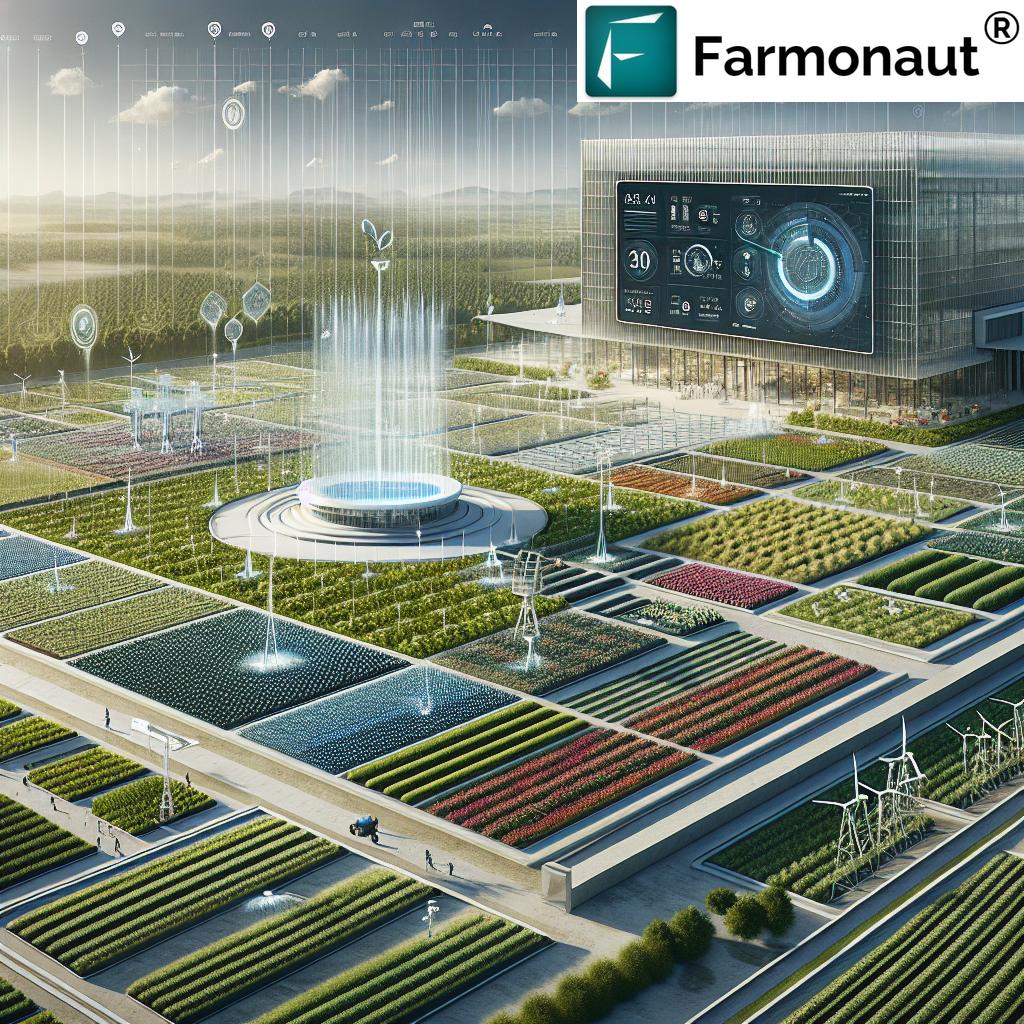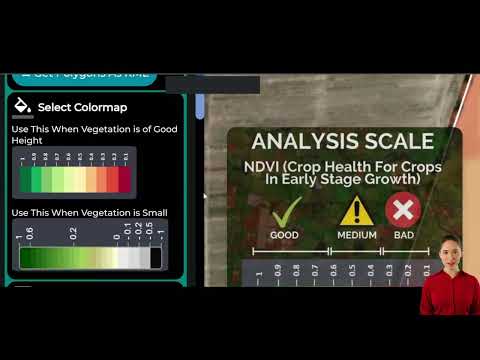Revolutionizing Agriculture: How GIS and Remote Sensing Drive Precision Farming Innovation in Sheffield
“GIS and remote sensing technologies can increase crop yields by up to 30% through precision agriculture techniques.”
Welcome to the cutting-edge of agricultural innovation! We’re thrilled to share insights from the groundbreaking AgriTech event hosted by KTN and Farm491 in Sheffield. This pivotal gathering has brought together the brightest minds in farming, research, and agritech entrepreneurship to explore the future of digital farm management and smart irrigation systems. Join us as we delve into how Geographic Information Systems (GIS) in agriculture and remote sensing for crop management are reshaping the industry, optimizing crop yields, and enhancing farm efficiency like never before.
The Dawn of Precision Agriculture in Sheffield
Sheffield, a city known for its industrial heritage, is now at the forefront of agricultural innovation. The convergence of GIS and remote sensing technologies is ushering in a new era of precision farming that promises to revolutionize how we grow food and manage our precious land resources.
At the heart of this revolution is the concept of precision agriculture technology. This approach uses data from satellites, drones, and ground sensors to provide farmers with detailed information about their fields. By leveraging this data, farmers can make more informed decisions about planting, irrigation, and harvesting, leading to significant improvements in crop yields and resource efficiency.

GIS in Agriculture: Mapping the Future of Farming
Geographic Information Systems (GIS) have become an indispensable tool in modern agriculture. These systems allow farmers to create detailed maps of their fields, overlaying various data points such as soil type, moisture levels, and crop health. This spatial analysis enables farmers to:
- Identify areas of low productivity
- Optimize planting patterns
- Plan efficient irrigation strategies
- Target fertilizer and pesticide applications
By utilizing GIS in agriculture, farmers in Sheffield and beyond are seeing remarkable improvements in their operations. The ability to visualize and analyze spatial data has opened up new possibilities for sustainable farming innovations that were previously unimaginable.
Remote Sensing: Eyes in the Sky for Crop Management
Remote sensing technology has emerged as a game-changer in crop management. Satellites and drones equipped with multispectral cameras can capture detailed images of farmland, providing valuable insights into crop health, soil moisture, and even pest infestations. This technology enables farmers to:
- Monitor crop growth patterns
- Detect early signs of disease or stress
- Estimate crop yields with greater accuracy
- Make timely decisions on irrigation and harvesting
The integration of remote sensing for crop management has been particularly impactful in Sheffield, where farmers are using this technology to adapt to changing weather patterns and optimize their use of resources.
Smart Irrigation Systems: Precision Water Management
Water is a precious resource, and smart irrigation systems are at the forefront of conservation efforts in agriculture. These systems use a combination of soil sensors, weather data, and crop-specific algorithms to determine the optimal amount and timing of irrigation. Benefits include:
- Reduced water waste
- Improved crop quality
- Lower energy costs for pumping
- Minimized runoff and soil erosion
In Sheffield, the adoption of smart irrigation systems has led to significant water savings while maintaining or even improving crop yields. This technology is particularly crucial in areas facing water scarcity or unpredictable rainfall patterns.
Digital Farm Management: The Command Center of Modern Agriculture
Digital farm management platforms are bringing all these technologies together, providing farmers with a centralized system to monitor and control their operations. These platforms integrate data from various sources, including:
- GIS maps
- Remote sensing imagery
- Weather forecasts
- Market prices
- Equipment telemetry
By leveraging these digital tools, farmers can make data-driven decisions that optimize every aspect of their operations. The result is increased efficiency, reduced costs, and improved sustainability.
“The global precision agriculture market is projected to reach $12.9 billion by 2027, growing at a CARP of 13.1%.”
Agricultural Data Analytics: Turning Information into Action
The true power of precision agriculture lies in the ability to analyze vast amounts of data and extract actionable insights. Agricultural data analytics tools are becoming increasingly sophisticated, employing machine learning and artificial intelligence to:
- Predict crop yields
- Optimize planting schedules
- Forecast pest outbreaks
- Recommend precise fertilizer applications
These analytical capabilities are transforming farm innovation research, allowing scientists and agronomists to develop new crop varieties and farming techniques that are more resilient and productive.

Crop Yield Optimization: The Holy Grail of Precision Farming
One of the most significant promises of precision agriculture is the potential for crop yield optimization. By combining all the technologies we’ve discussed, farmers can create a virtuous cycle of improvement:
- Collect data through GIS and remote sensing
- Analyze this data to identify areas for improvement
- Implement targeted interventions using smart irrigation and precision application of inputs
- Monitor the results and refine the approach
This iterative process allows for continuous improvement, leading to ever-increasing yields while minimizing environmental impact.
The Role of Agritech Startups in Driving Innovation
Agritech startups are playing a crucial role in driving the adoption of precision agriculture technologies. These innovative companies are developing new tools and platforms that make advanced technologies accessible to farmers of all sizes. Some key areas where startups are making an impact include:
- Developing user-friendly interfaces for complex GIS tools
- Creating affordable remote sensing solutions using drones and small satellites
- Designing IoT devices for real-time field monitoring
- Building AI-powered decision support systems for farm management
The AgriTech event in Sheffield has showcased many of these promising startups, highlighting the vibrant ecosystem of innovation in the agricultural sector.
Sustainable Farming Innovations: Balancing Productivity and Environmental Stewardship
As we push the boundaries of agricultural productivity, it’s crucial to maintain a focus on sustainability. The precision agriculture technologies we’ve discussed are not just about increasing yields; they’re also about minimizing the environmental impact of farming. Sustainable farming innovations enabled by these technologies include:
- Reduced use of chemical inputs through targeted application
- Improved soil health through data-driven crop rotation and cover cropping
- Enhanced biodiversity through precision conservation practices
- Decreased greenhouse gas emissions through optimized machinery use
These innovations are helping farmers in Sheffield and around the world to produce more food while preserving the land for future generations.
The Future of Farming: Integrating Technologies for Maximum Impact
As we look to the future, the true power of precision agriculture will come from the integration of multiple technologies. We’re seeing exciting developments in areas such as:
- Automated farming systems that combine GIS, remote sensing, and robotics
- Blockchain-based supply chain management for improved traceability
- Advanced weather forecasting models that help farmers adapt to climate change
- Genetic engineering techniques informed by big data analytics
These integrated solutions promise to take precision farming to new heights, further increasing productivity while enhancing sustainability.
Farmonaut: Bridging the Gap Between Technology and Agriculture
In the realm of precision agriculture, Farmonaut stands out as a pioneering force, offering advanced satellite-based farm management solutions. Their platform integrates cutting-edge technologies to make precision agriculture more accessible and affordable for farmers worldwide.
Farmonaut’s suite of tools includes:
- Satellite-Based Crop Health Monitoring
- AI-Powered Advisory Systems
- Blockchain-Based Traceability Solutions
- Fleet and Resource Management Tools
- Carbon Footprinting Capabilities
These innovative solutions align perfectly with the themes of the AgriTech event in Sheffield, showcasing how technology can be harnessed to transform agricultural practices.
Explore Farmonaut’s offerings:
For developers looking to integrate Farmonaut’s technology:
Get Farmonaut on your mobile device:
AgriTech Innovations Showcase
| Technology | Application | Benefits | Estimated Adoption Rate |
|---|---|---|---|
| GIS in Agriculture | Field mapping, soil analysis, yield monitoring | Improved resource allocation, targeted interventions | 45% of UK farmers |
| Remote Sensing for Crop Management | Crop health assessment, pest detection, yield prediction | Early problem detection, optimized crop management | 35% of UK farmers |
| Smart Irrigation Systems | Precision water application, soil moisture monitoring | Water conservation, improved crop quality | 30% of UK farmers |
| Agricultural Data Analytics | Yield forecasting, risk assessment, market analysis | Data-driven decision making, improved profitability | 40% of UK farmers |
Challenges and Opportunities in Precision Agriculture Adoption
While the benefits of precision agriculture are clear, there are still challenges to widespread adoption. These include:
- Initial investment costs for technology and equipment
- Need for technical skills and training
- Data privacy and security concerns
- Integration of new technologies with existing farm practices
However, these challenges also present opportunities for innovation and collaboration. Government initiatives, public-private partnerships, and educational programs are all playing a role in overcoming these barriers and accelerating the adoption of precision farming techniques.
The Role of Research and Education in Advancing Precision Agriculture
Universities and research institutions are playing a crucial role in advancing precision agriculture. Through farm innovation research, these institutions are:
- Developing new sensor technologies for more accurate data collection
- Creating advanced algorithms for data analysis and decision support
- Conducting field trials to validate the effectiveness of precision farming techniques
- Training the next generation of agricultural professionals in cutting-edge technologies
The collaboration between academia, industry, and farmers is essential for driving continued innovation in the field.
The Economic Impact of Precision Agriculture
The adoption of precision agriculture technologies is having a significant economic impact on the farming sector. Benefits include:
- Increased profitability through higher yields and reduced input costs
- Creation of new jobs in agritech and related fields
- Development of new markets for agricultural data and services
- Improved competitiveness of local farms in global markets
As these technologies continue to evolve and become more accessible, we expect to see even greater economic benefits for farmers and rural communities.
Precision Agriculture and Climate Change Mitigation
One of the most promising aspects of precision agriculture is its potential to contribute to climate change mitigation efforts. By optimizing resource use and reducing waste, these technologies can help:
- Decrease greenhouse gas emissions from farming activities
- Improve carbon sequestration in agricultural soils
- Enhance the resilience of farming systems to extreme weather events
- Reduce the overall environmental footprint of agriculture
As we face the challenges of a changing climate, precision agriculture will play an increasingly important role in ensuring food security while minimizing environmental impact.
The Future of Food: From Farm to Fork
The impact of precision agriculture extends beyond the farm gate. These technologies are enabling:
- Improved traceability and transparency in food supply chains
- Enhanced food quality and safety through precise control of growing conditions
- Development of new, more sustainable food products
- Closer connections between consumers and producers through data-driven storytelling
As consumers become more conscious of where their food comes from and how it’s produced, precision agriculture technologies will play a key role in meeting these demands for transparency and sustainability.
Conclusion: A New Era of Sustainable, Data-Driven Agriculture
The AgriTech event in Sheffield has showcased the incredible potential of precision agriculture technologies to revolutionize farming. From GIS and remote sensing to smart irrigation systems and advanced data analytics, these innovations are paving the way for a more productive, sustainable, and resilient agricultural sector.
As we look to the future, it’s clear that the integration of these technologies will continue to drive innovation in farming practices. By embracing these advancements, farmers in Sheffield and around the world can meet the growing demand for food while preserving our precious natural resources for generations to come.
The journey towards fully digitized and optimized farming is just beginning, and we’re excited to be part of this agricultural revolution. Together, we can create a future where technology and nature work in harmony to feed the world sustainably.
FAQs
- What is precision agriculture?
Precision agriculture is a farming management concept that uses technology to observe, measure, and respond to variability in crops, with the goal of optimizing returns while preserving resources. - How does GIS benefit agriculture?
GIS in agriculture helps farmers create detailed maps of their fields, analyze soil conditions, plan efficient irrigation, and target the application of fertilizers and pesticides, leading to improved crop management and yields. - What role does remote sensing play in crop management?
Remote sensing uses satellite or drone imagery to monitor crop health, detect early signs of disease or stress, estimate yields, and inform decision-making about irrigation and harvesting. - How do smart irrigation systems work?
Smart irrigation systems use soil sensors, weather data, and crop-specific algorithms to determine the optimal amount and timing of irrigation, reducing water waste and improving crop quality. - What are the main challenges in adopting precision agriculture technologies?
The main challenges include initial investment costs, the need for technical skills and training, data privacy concerns, and integrating new technologies with existing farm practices.






